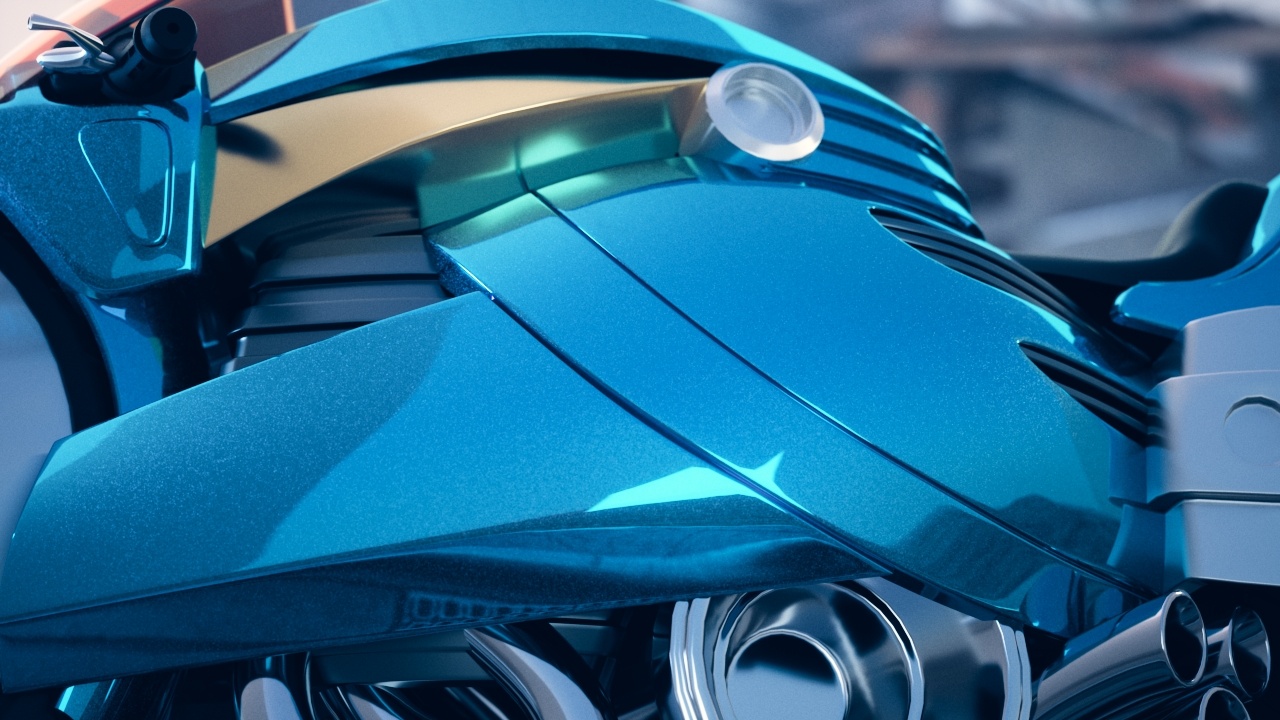This page provides information about the VRayFlakes2Mtl in V-Ray for Maya.
Overview
VRayFlakesMtl2 is a material that simulates the metallic flakes found in car paints. It is a complex material generated by the mixing of several textures and can be used in blend materials to add metallic flakes to other shaders. The VRayFlakesMtl2 uses GGX distribution which makes it fast and memory efficient.
Flake parameters
Flake Color – Specifies the color or map of the metal flakes.
Flake Random Color – Sets colors from the specified map (e.g. File or Ramp) to the flakes in a random pattern. Only the bottom row on u-axis of the map is sampled for colors. See the Flake Random Color example below for more information.
When using the Flake Random Color, Flake Color acts as a filter. Set the Flake Color option to white (255, 255, 255) to switch off its effect.
Flake Orientation – Specifies the orientation value or map of the metal flakes. The orientation of the flakes is relative to the surface normal . When this value is 0.0, all flakes are perfectly aligned with the surface. When set to 1.0, the flakes are rotated completely randomly with respect to the normal. Values above 0.5 are not recommended as they can produce artifacts. See the Flake Orientation example below for more information.
Flake Orientation Tail – Controls the transition from highlighted areas to non-highlighted areas.
Flake Glossiness – Specifies the reflection glossiness value of the flakes.
Flake Density – Specifies the density (number of flakes) for a certain area. Lower values produce less flakes, and higher values produce more flakes. When set to 0.0, it produces a material without flakes. See the Flake Density example below for more information.
Flake Scale – Scales the entire flake structure. See the Flake Scale example below for more information.
Flake Scale Triplanar – Active only when Mapping Type is set to Triplanar. Scales the entire flake structure.
Flake Size – Specifies the size of the flakes relative to the distance between them. Higher values produce bigger flakes, and lower values produce smaller flakes. See the Flake Size example below for more information.
Flake Map Size – Internally the material creates several bitmaps to store the generated flakes. This parameter determines the size of the bitmaps. Lower values reduce RAM usage, but may produce noticeable tiling in the flake structure. Higher values require more RAM, but tiling is reduced.
Flake Seed – Specifies the random seed for the flakes. Changing this produces different flake patterns.
Flake UV Coords – Allows connecting a texture placement node.
Mapping Type – Specifies the method for mapping the flakes. The possible values are:
Mapping channel – The flakes are mapped using the specified channel.
Triplanar – The material automatically computes mapping coordinates in object space based on the surface normals.
Mapping Channel – Specifies the mapping channel for the flakes when the Flake mapping type is set to Mapping channel.
Example: Flake Random Color
This example shows the Flake Random Color parameter used with a Ramp map with Type set to U Ramp with six randomly set colors. Flake Density is set to 20; Flake Size is set to 0.4; Flake Scale is set to 0.5; Flake Color is set to white (255,255,255).
Example: Flake Orientation
For this example, Flake Size is set to 0.3 and Flake Density is set to 20; the other parameters use their default values.
Example: Flake Density
For this example, Flake Size is set to 0.3 and the other parameters are at their default values.
Example: Flake Scale
For this example, Flake Size is set to 0.3 and Flake Density is set to 20. The rest of the parameters are at their default values.
Example: Flake Size
For this example, Flake Density is set to 20. The rest of the parameters are at their default values.
Options
These options are inactive with V-Ray GPU enginе.
Trace Reflections – Global switch to toggle reflections for the flakes.
Trace Depth – Specifies the number of times a ray can be reflected.
Double Sided – When enabled, the material is double-sided.
Cutoff Threshold – Specifies the cutoff threshold for the reflections of the different layers.
Environment Override
Use Environment Override – When enabled, allows you to specify a local environment map for reflections and refractions.
Environment Override Texture – Specifies a map for the environment override.
Environment Override Priority – Specifies the environment priority for the Environment override texture for this material.
































